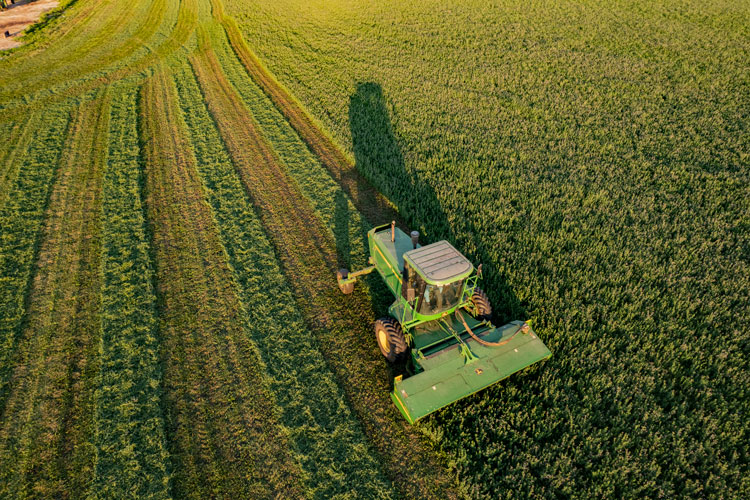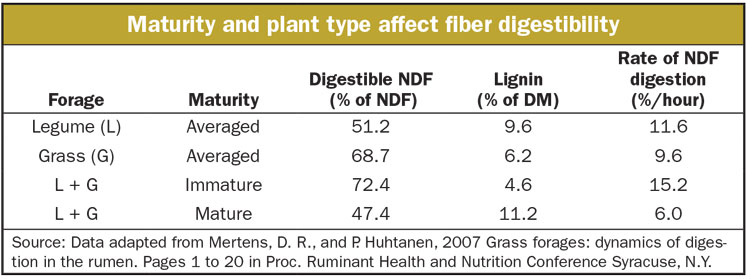
For many readers, first cut will be just around the corner as you read this article. To say the least, unlocking the energy in your forages to fuel herd performance is a top priority during first cutting since it provides so much tonnage and makes up a substantial portion of the annual forage inventory. With alfalfa, the fiber digestibility is often highest for first cut because it has grown at cooler temperatures.
Depending on spring weather, the ideal time for beginning first cut may occur while the last of the corn is being planted. In short, first cutting can be a hectic time of the year. Focusing on some fundamental concepts of forage quality ahead of the hustle and bustle of first cutting is a profitable and wise use of one’s time.
Quality changes rapidly
We all know that getting the right quality of forage into your cows results in higher milk component yields, less purchased grain, and overall higher income over feed cost. Research tells us that, on average, each 1% unit improvement in neutral detergent fiber (NDF) digestibility correlates with about an extra 0.40 pound per day of dry matter intake and 0.50 pound daily of milk. Herds that focus on forage management — and have the ability to harvest at optimal maturity regardless of weather — produce more milk with lower feed costs.
Forage quality is a function of the forage type (such as grass or legume), maturity at harvest, and the environmental conditions during growing, harvesting, and storage. Maturity at harvest is a critical factor for NDF digestibility and my main focus for this article.

Bear in mind how rapidly forage quality can change in the field. We sometimes forget how quickly NDF digestibility can drop. Wisconsin research indicates that NDF content of alfalfa jumps about 0.4% unit each day and NDF digestibility drops by the same amount — not a desirable combination!
Similarly, Cornell University work found that the NDF digestibility of alfalfa declines between 0.5% and 1% unit for each day that harvest is delayed . . . and the NDF digestibility for grasses can plummet even faster.
Other research indicates that alfalfa quality declines at a faster rate during first cutting than later cuttings. With the scarcity of rain-free days during first cut in many parts of the country, we need to be ready to go when weather and drying conditions are right.
Achieving the correct maturity at harvest is important for both grasses and legumes. Given the compositional differences between grasses and legumes, many dairy producers expend considerable time deciding what type of forages to plant or purchase for their herd.
This is an important question, and every farm needs to have the proper mix of forage NDF sources to promote feed intake, rumen fiber digestion, and milk component yields. But if the goal is to harvest digestible NDF, what is more important — the plant type (grass or legume) or getting the crop harvested while it is immature?
To answer that question, we need to understand how grasses and legumes naturally differ in NDF digestibility when they are mature or immature. Fortunately, over a decade ago when Dave Mertens was at the U.S. Dairy Forage Research Center in Madison, Wis., he summarized the published research that compared NDF digestibility of grasses and legumes. The table presents some of the key findings of his research review.
First, all the data for legumes and grasses were averaged regardless of maturity. As we look at these first two lines of data in the table, we see that digestible NDF is substantially greater for grasses than legumes while lignin is lower, but alfalfa has a more rapid rate of fiber digestion. These are the well-known and essential characteristics of typical grasses and legumes.
Now let’s focus on the last two lines in the table where the research data have been separated by stage of maturity but averaged across both grasses and legumes. Averaged across forage type, immature forages contain much less lignin and have substantially better NDF digestibility as we would expect.
Here is the main point: The effect of maturity on NDF digestibility is much larger than any basic difference between grasses and legumes. For instance, the range in digestible NDF between grasses and legumes is about 18 percentage units, but that same range is nearly 25 percentage units for mature versus immature grass and legume forages. The effect of maturity on the range in lignin and rate of NDF digestion is even more pronounced.
As first cut approaches, you will only be able to maximize the harvest of energy from your grass and legume forages by cutting them at the right maturity when fiber digestibility is optimal.
Target highly digestible NDF
High-producing cows require highly digestible NDF. A typical range in 30-hour NDF digestibility for alfalfa would be about 45% to nearly 60%. This range is essentially the mean value for 30-hour NDF digestibility, plus or minus one standard deviation. Similarly, grass may range between 55% and 70% for 30-hour NDF digestibility. When feeding high-producing cows, we need to target the higher end of these ranges in order to boost feed intake and milk component yield.
As you get ready for first cut, bear in mind that maturity at harvest is crucial — and it has an overriding impact on fiber digestibility for any combination of grasses and legumes. Whatever the forages are on your farm, harvesting at the right stage will maximize the energy you capture from those forages.
As a young extension specialist over three decades ago, one of the first chestnuts of wisdom I heard from a dairy farmer I was visiting was this: “Highly digestible forage does not ensure high milk yield, but low digestibility forage guarantees the opposite!” Focus on maturity at harvest with your all-important first cut and you are bound to boost your bottom line.











